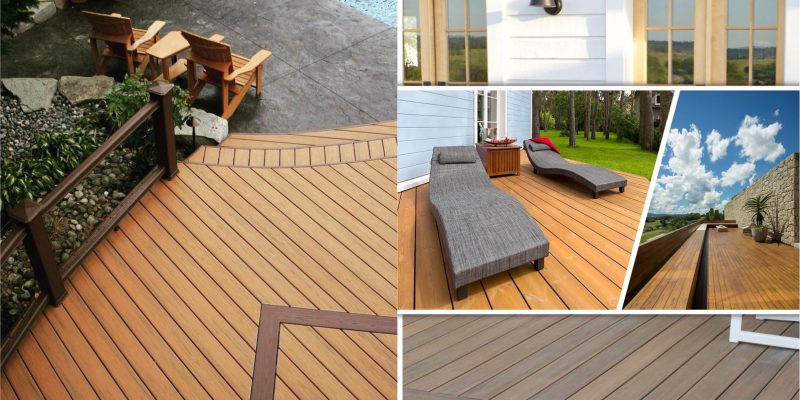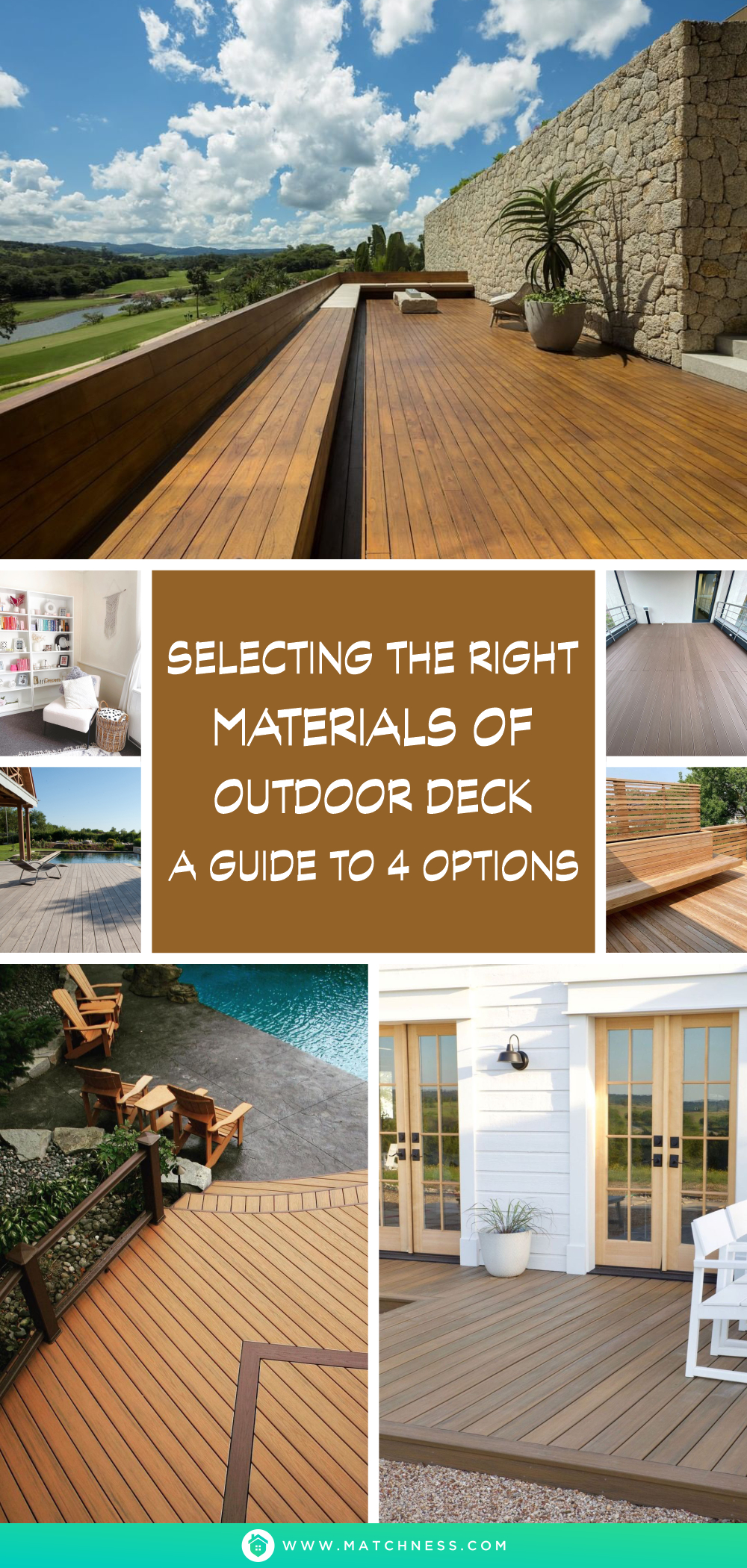Choosing the right decking material can be a challenging task due to the multitude of options available. We aim to simplify the process for you, as the best material will vary depending on personal circumstances such as budget, intended length of time in the home, and the intended use of outdoor spaces. There are four main categories of decking material: wood, plastic, fiberglass, and aluminum. Each material has its pros and cons, so it’s essential to consider them all and determine which one best fits your specific needs.
Wood decking
Wood decking has long been a favorite among homeowners and continues to be so today. Many people appreciate the classic and natural appearance of real wood decking when it comes to choosing material for their outdoor deck. Within the category of wood decking, there is a wide range of options to consider:
- Pressure Treated Wood: Pressure-treated wood is an economical option for decking material and is widely used. The process involves treating Southern yellow pine with chemicals to enhance its durability and protect it from insects and moisture. Despite its low cost, pressure-treated wood requires significant upkeep to maintain its appearance. This includes regularly applying coats of stain and sealer and pressure washing the deck. Additionally, the boards may require sanding to prevent splinters. Despite these efforts, over time and with exposure to the elements, pressure-treated wood is prone to cracking, warping, and shrinking.
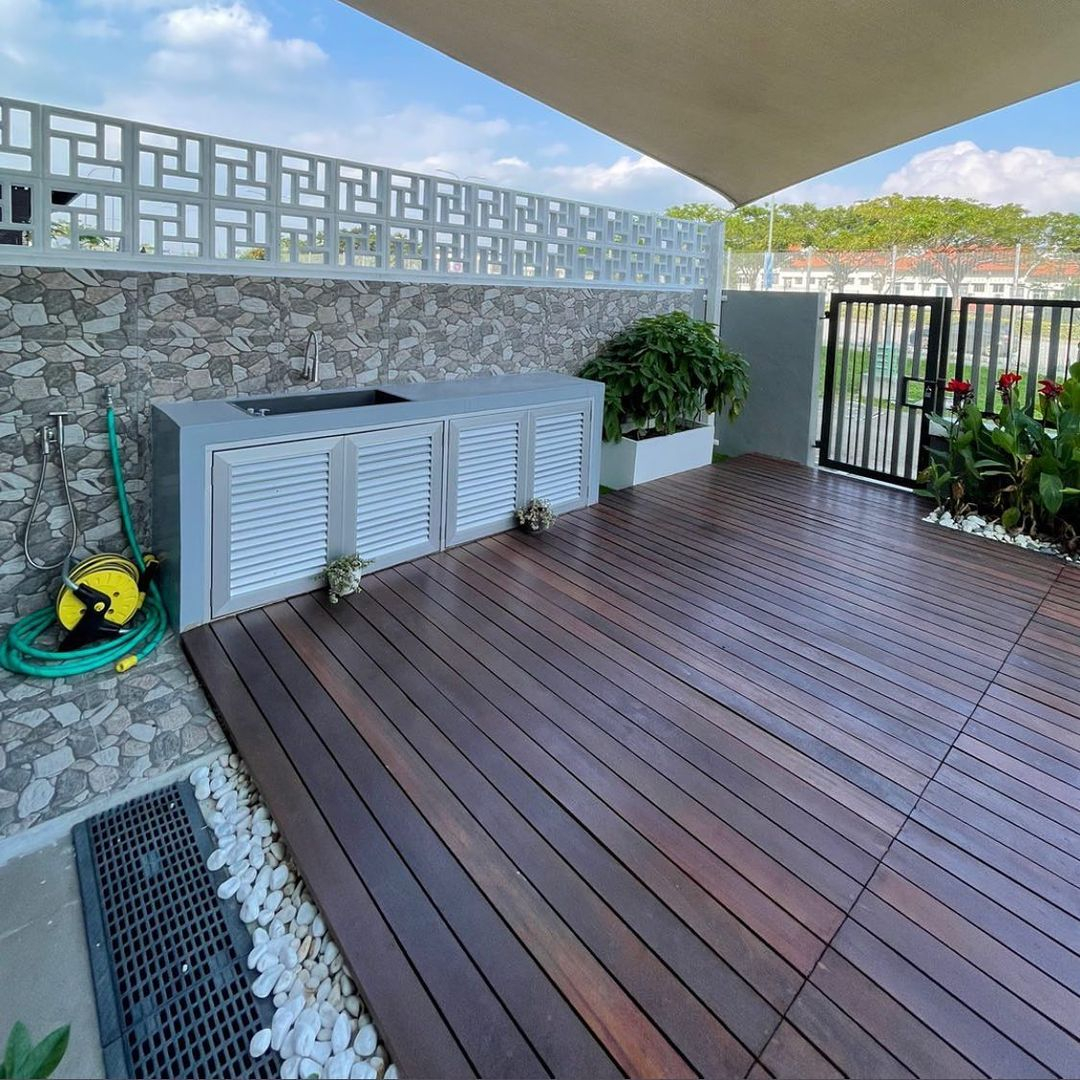
You can use wood on your deck to appear strong and sturdy in any weather. You can paint this wooden deck in a dark color which will make your terrace look more attractive and steal the eye. Using this wood material will also be easy to clean by spraying it with water or using a broom. Wooden Decking from @athari.flowers.pots
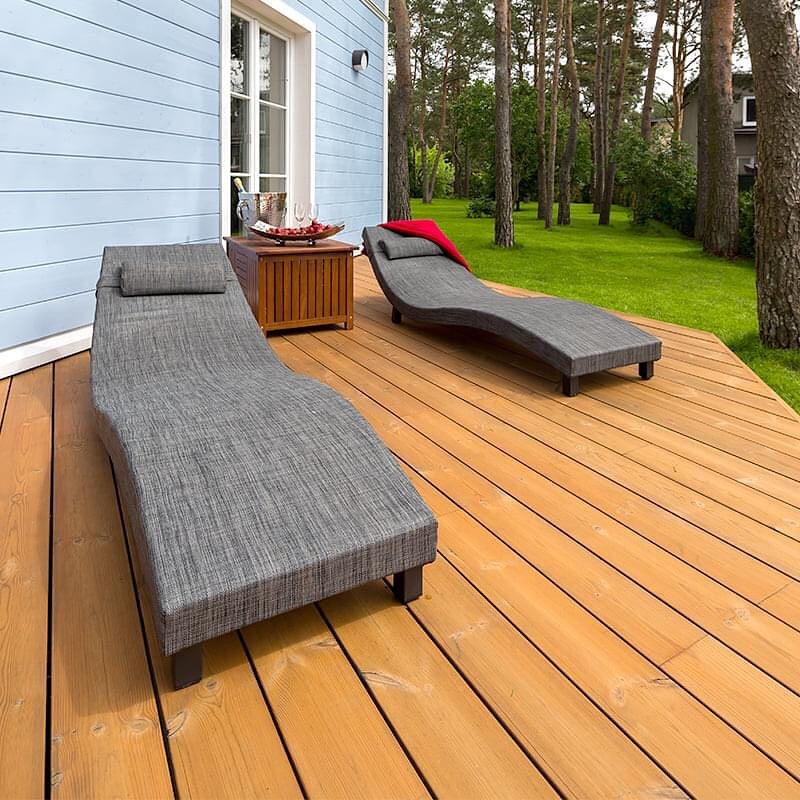
This house terrace deck uses wood which will make the appearance more attractive and strong. The maintenance is quite easy, you just need to repaint it so that the wood is not easily porous and will last longer. Light Wood Decking from @russinlumbercorp
- Cedar And Redwood: Cedar and Redwood decking are also popular options among homeowners due to their rich color and natural beauty. Both woods contain tannins that make them resistant to rot and insects. Redwood decking is pricier than pressure-treated wood and requires similar maintenance, while Cedar is more readily available and less expensive but requires the same upkeep as pressure-treated wood and Redwood. Prolonged exposure to direct sunlight can cause fading of the natural color, shrinkage, and splitting in Cedar and Redwood decking. To prevent fine splits and maintain the color, it’s essential to pressure wash these decks and reapply a sun-blocking stain and sealer at least every three years.
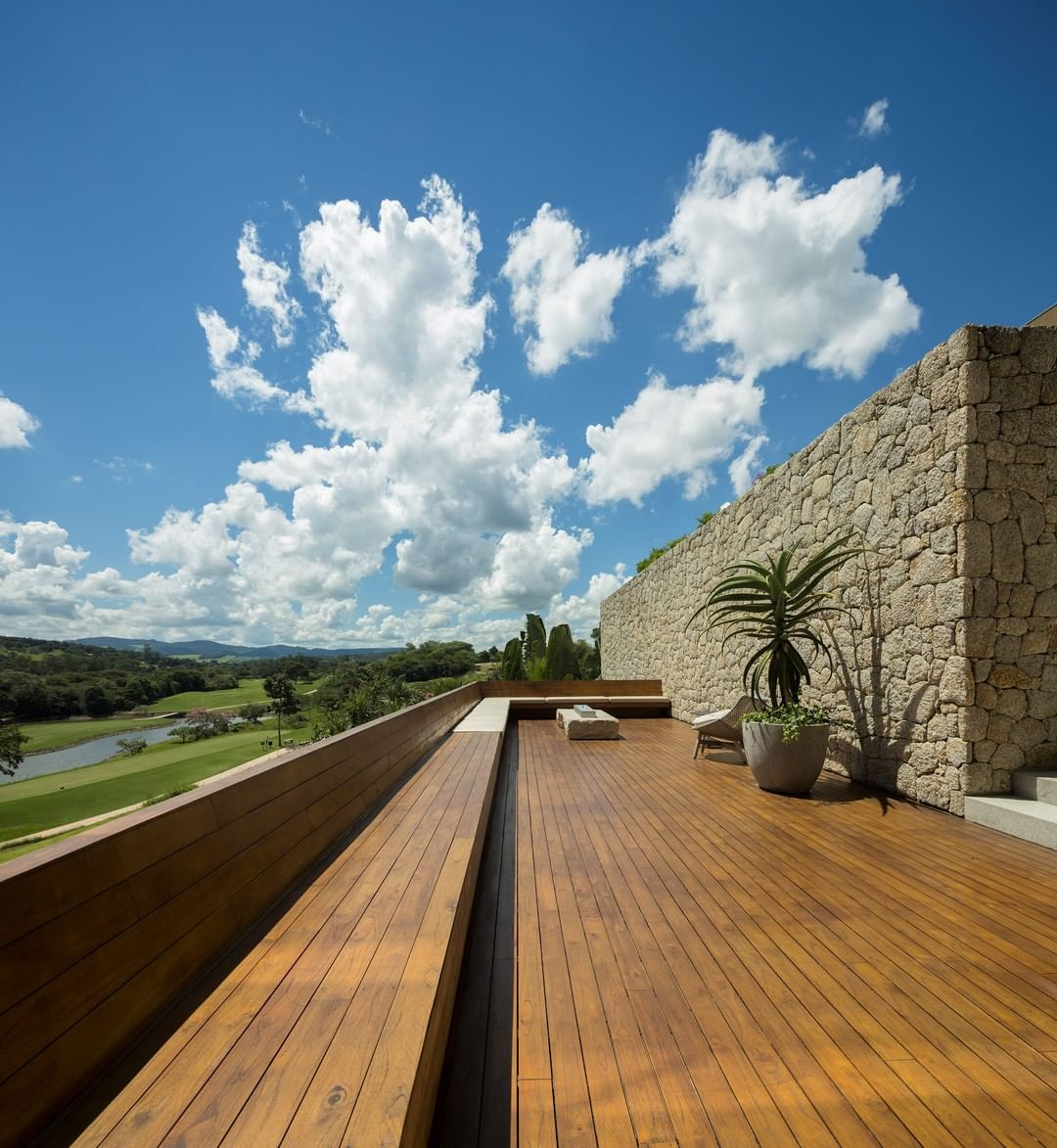
Wooden decks using cedar wood are less expensive and provide easy maintenance. You also need to try coating wood with termite-resistant paint to keep your wood safe from insects and decay. On this deck, you can also equip it with a wooden bench to spend time with your family on the terrace of your house. Cedar Wood Deckingfrom @neobambu
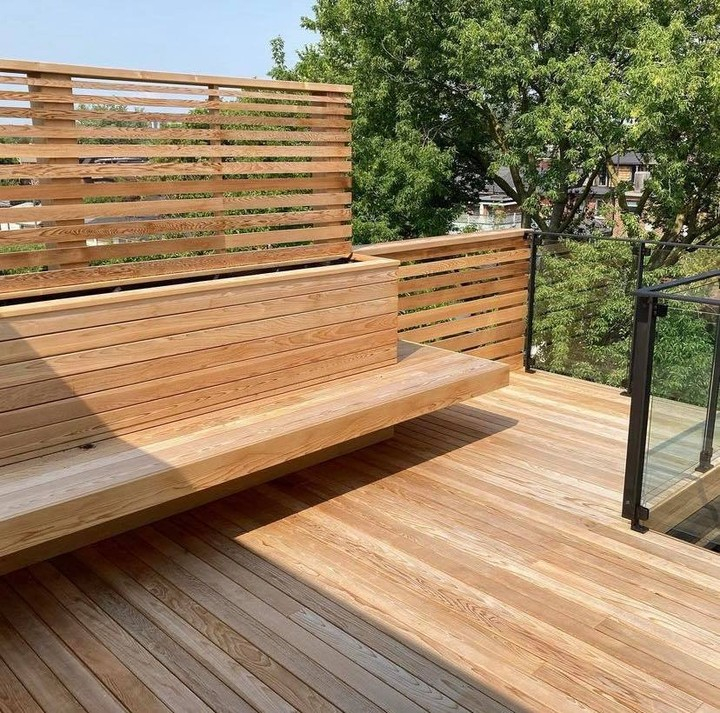
The wood deck which is equipped with this bench has an attractive appearance for you to try on your terrace. Using cedar wood is also easy to maintain. Applying waterproof paint will also prevent animal attack and the wood is porous. Wooden Deck and Bench from @qualitycedarproducts
- Tropical Hardwoods: If budget is not a concern, exotic hardwoods such as Ipe, Tigerwood, Garapa, and Teak can offer a stunning and long-lasting decking solution. These hardwoods are popular among homeowners who seek a luxurious and high-quality deck.

This wooden deck uses rough wood which will give it a strong and sturdy appearance. This type of deck also gives a luxurious and luxurious appearance. Outdoor Wooden Deck from @accoyawood
Pros and Cons of Wood Deck Boards:
Pros:
- Appearance: Home owner adore the appearance and sensation of a wooden deck that is authentic. Although synthetic decking materials may attempt to duplicate this appearance, it never matches the beauty of a deck made from natural wood.
- Cost: Pressure-treated lumber is the most cost-effective form of decking material.
Cons:
- Maintenance: Wood decking is the most demanding deck materials in terms of labor as it requires continuous upkeep.
- Durability: Most wood decking has a shorter lifespan compared to synthetic decking materials and will require replacement sooner.
Plastic decking
There are three main categories of plastic decking:
- PVC Decking: Polyvinyl chloride (PVC) decking is a contemporary alternative for deck building, which provides durability and requires minimal upkeep. Its boards mimic the appearance of real wood and have added features that prevent rot and insect infestation. Furthermore, these boards are recyclable, making them more eco-friendly compared to traditional wooden boards.
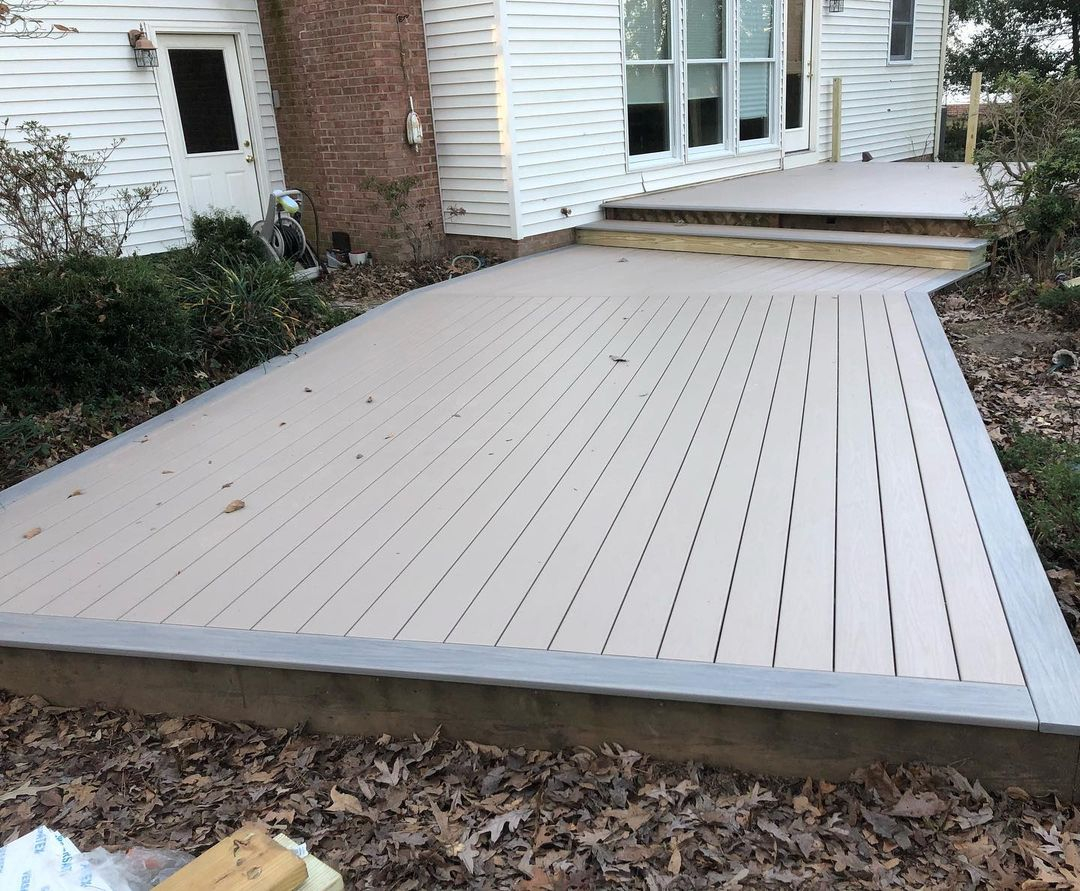
This PVC deck has a wood-like appearance that will give your terrace a contemporary style. The choice of PVC material is also minimal maintenance so it will prevent porous and insects. This type of deck will also be environmentally friendly compared to wood decks. PVC Deck from @stimisenterprises
- HDPE Decking: High-density polyethylene (HDPE) decking, like PVC decking, is made entirely of plastic. It also mimics the appearance of natural wood with its wood-like colors and grain patterns. But, in contrast to PVC decking, HDPE decking does not produce any harmful chemicals during its manufacturing process.
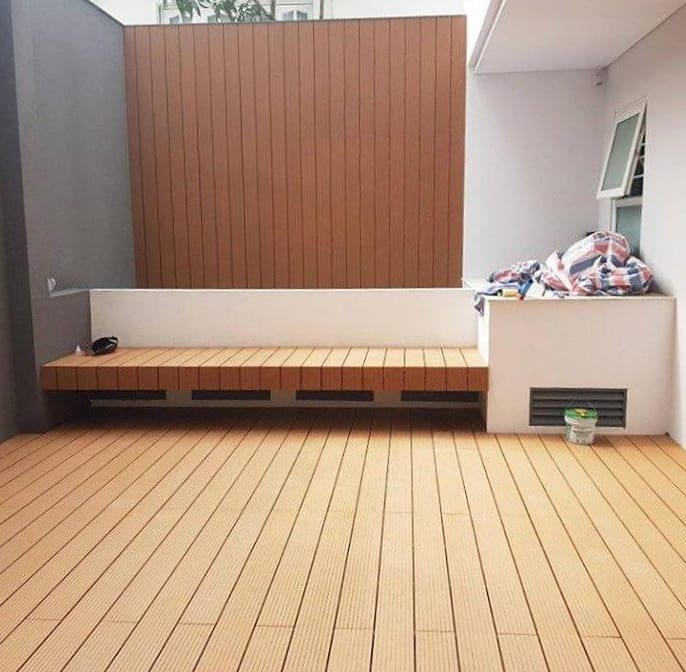
Having a look like HDPE deck wood is also minimal maintenance. Using this deck will also prevent decay and animal attacks. Adding this bench will also provide comfort when you are on the terrace of this house. HDPE Decking from @revtama.flooring
- Composite Decking: Composite decking is created from a blend of wood fibers and plastic. This type of decking material has a more wood-like appearance compared to plastic decking. Additionally, it is softer on bare feet than decks made solely of plastic. Although it is not completely maintenance-free, composite decking is a low-maintenance option that requires less upkeep compared to a traditional wooden deck.
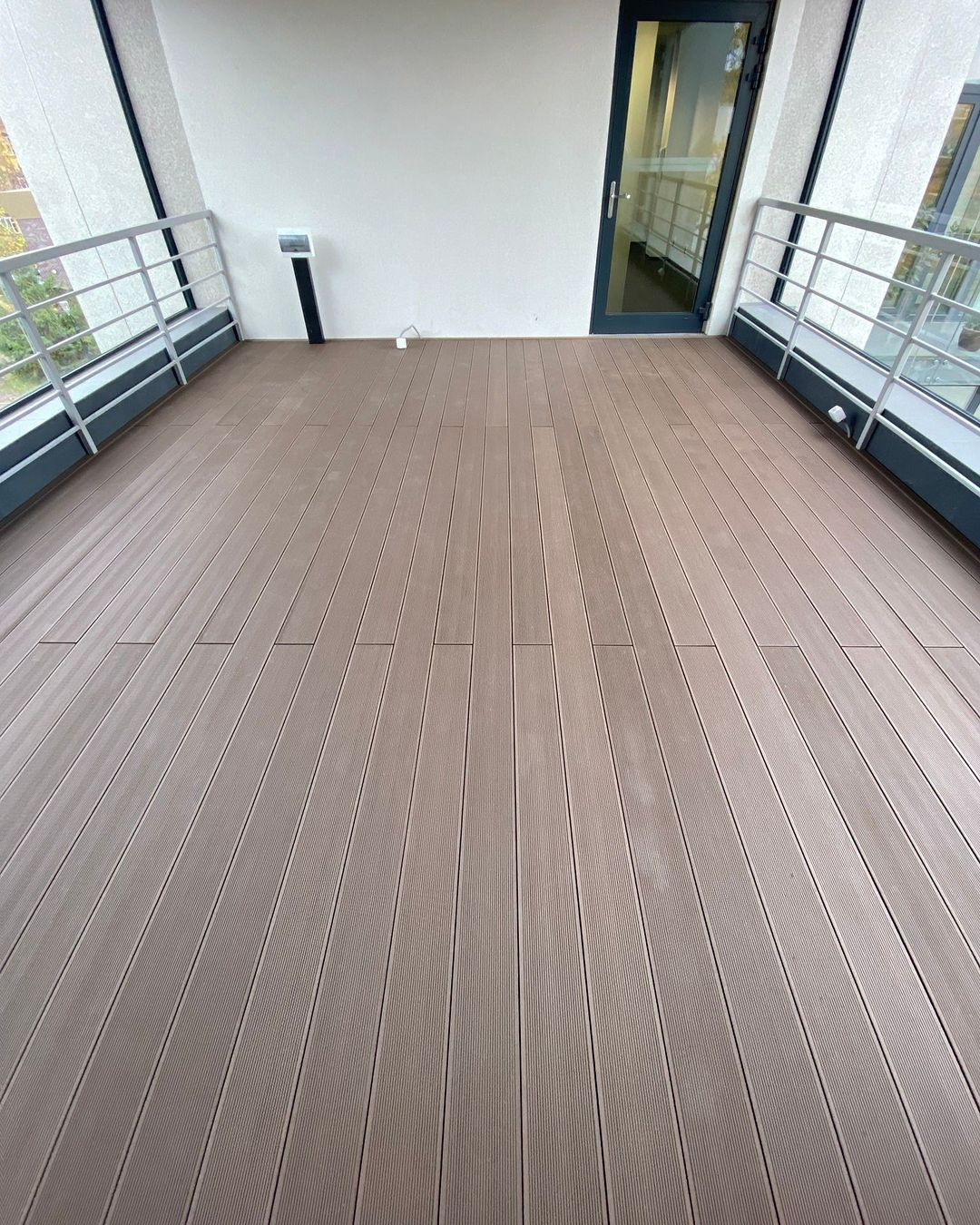
This composite deck has a shape and texture like wood. using a deck like this will certainly last a long time and minimal maintenance. This deck also has a softer texture than a wooden deck. Composite Deck Area from @deski.tarasowe
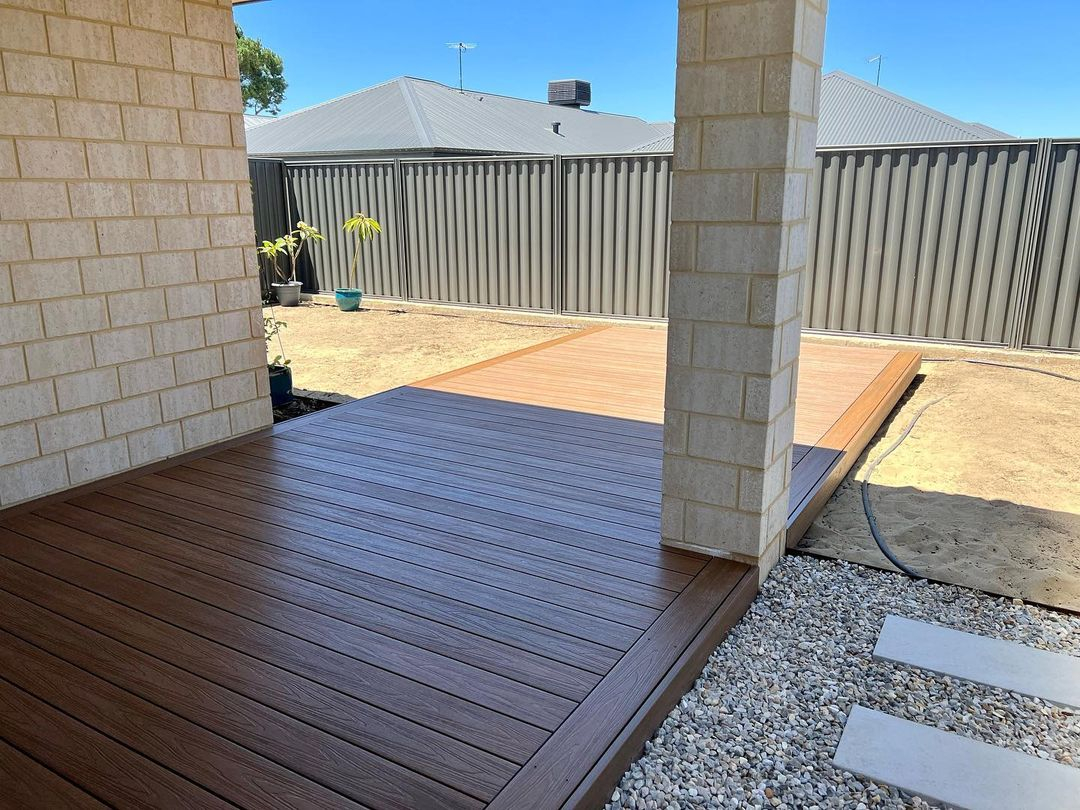
Applying composite decking to the terrace of this house is a good choice for you to try. Here this composite deck has a softer texture than plastic. This type of deck is also minimal maintenance and will be porous as well.Composite Decking from @amity_scapes
Pros and cons of plastic decking:
Pros:
- Maintenance: Plastic decks require minimal upkeep to maintain their appearance.
- Durability: These types of decks are durable and last anywhere from 25-50 years.
- Environmental impact: Some of these products are made from recycled plastic and many of them can be recycled after use.
Cons:
- Appearance: Despite efforts by manufacturers to imitate the appearance of natural wood, plastic decking still retains a synthetic look instead of a natural one.
- Cost: Plastic decking is one of the more expensive materials for decking.
- Feel: Plastic decking can become excessively hot in sunlight, making it uncomfortable to walk on with bare feet. Wood composite decking, on the other hand, is more comfortable to walk on than purely plastic decks.
Fiberglass decking
Fiberglass, as a synthetic alternative, performs exceptionally well in areas with extreme temperatures. Additionally, it is a favorable choice for homeowners in moderate climates because it provides a strong and durable deck that is resistant to both moisture and insects.

choosing fiberglass material on this deck is suitable for you to try if you are in extreme temperatures. This material will withstand any weather and will last longer. You can add this fiberglass material to your patio deck for an interesting outdoor design for you to try. Fiberglass Deck from @mcnicholsco
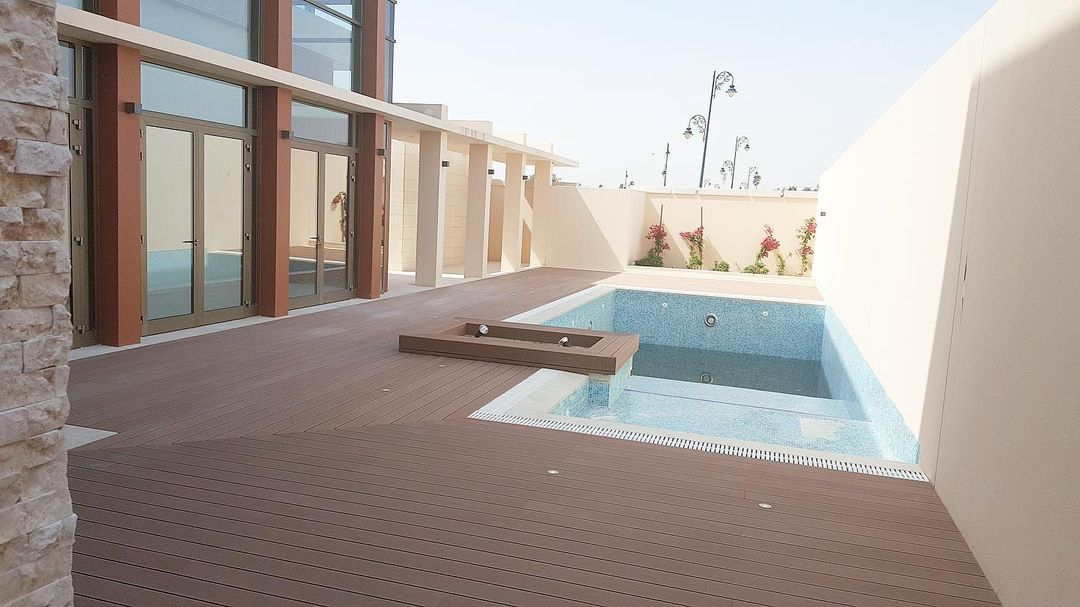
Fiberglass deck. Having a soft texture and being resistant to extreme weather, this is an interesting choice for you to try. This type of deck will be durable and resistant to moisture and insects. Fiberglass Decking from @alwatyanflooring

The terrace of the house which has a farmhouse style uses fiberglass decks which will last longer in extreme weather. This is an advantageous option as it gives the deck a long life and resistance to moisture, insects. Farmhouse Fiberglass Decking from @fortressbldgproducts
Fiberglass Pros and cons:
Pros
- Durability: Fiberglass is a durable solution, with the potential to last for 25 to 30 years with proper maintenance.
- All-weather: Fiberglass is good in extreme temperatures like in areas of the far north that are exposed to harsh winters.
Cons
- Cost: A fiberglass deck requires a significant upfront investment.
- Appearance: Fiberglass decks are often disliked due to their smooth surface which differs from wood, and the limited color options compared to other synthetic materials.
Aluminum decking
Although a smaller subset of deck material, aluminum decking is a low-maintenance and durable option that resists rot, decay, and insects. It can last up to 20 years with proper care, and although it imitates the appearance of wood, it cannot perfectly replicate its texture and natural look.
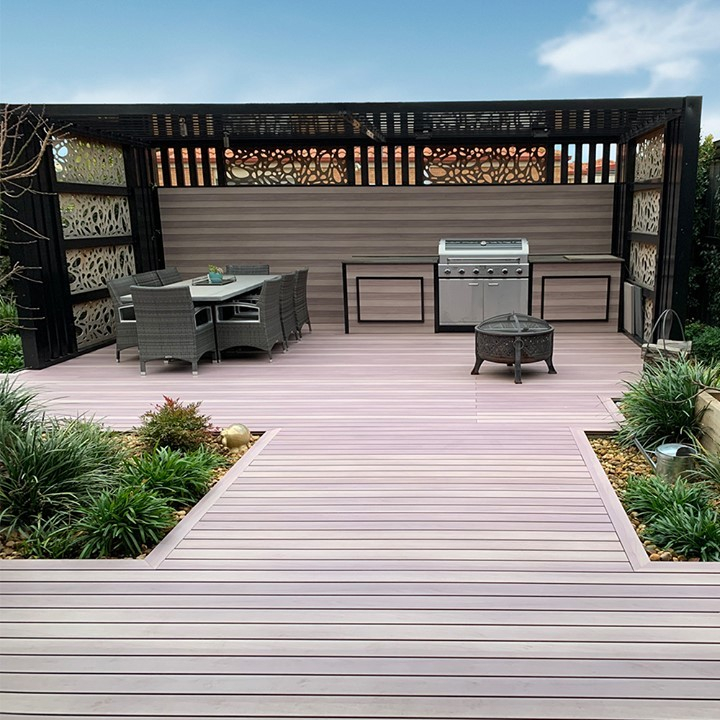
This aluminum deck mimics the look of wood but not the texture. This type of deck will last 20 years and this type of deck has minimal maintenance. Choosing this type of deck will also produce interesting garden decorations for you to try. Aluminium Decking from @deco_australia
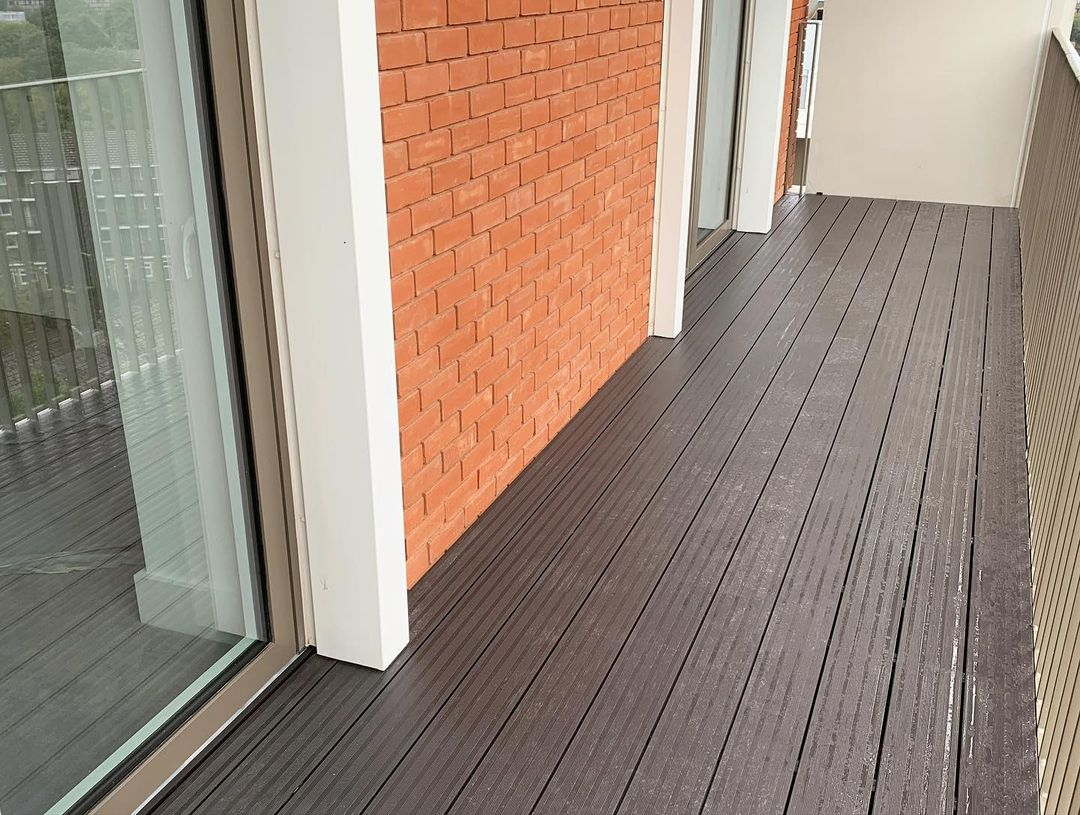
Decks using aluminum are minimal maintenance and will last longer. This type of deck has a wood-like appearance but not the texture. This material will last longer and make your home look more attractive for you to try. Aluminium Decking System from @am_roofer
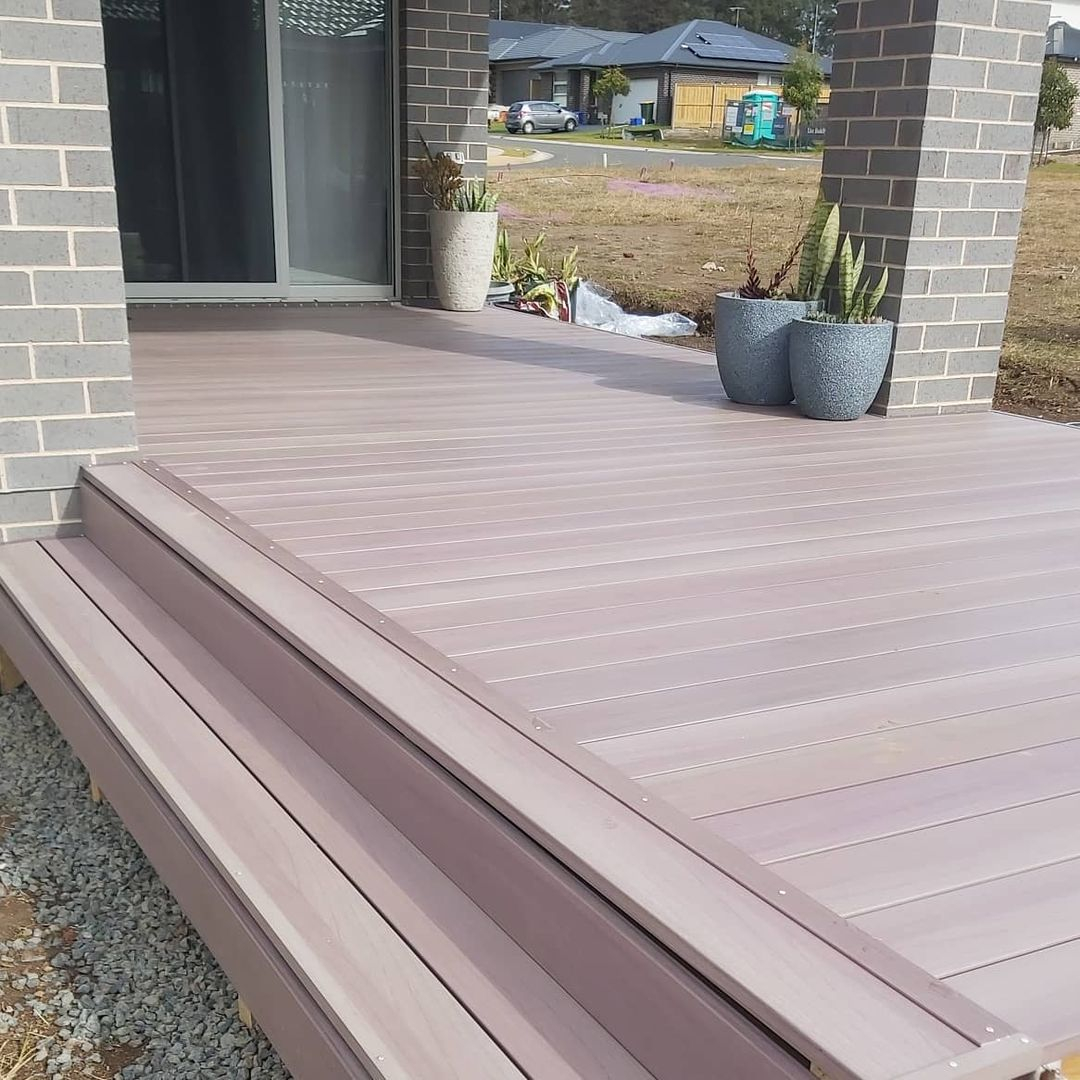
Lastly, this aluminum deck has a wood-like appearance but not the texture. This deck will last 20 years and give your home a different look. Having a wood-like appearance is also minimal maintenance and will last longer. Aluminium Wood Decking from @building_thebronx24
Aluminum pros and cons:
Pros
- Durability: This is a long-lasting decking material option. It will last around 20 or more with the proper maintenance.
- Feel:Although darker aluminum decks may become hot in the sun, their hollow core allows them to cool down quickly. Additionally, aluminum decking typically features a non-skid surface to prevent slipping.
- Maintenance: These decks can maintain their great appearance without the need for constant maintenance.
Cons
- Cost: Compared to wood and other materials, aluminum decking is typically more expensive. Nonetheless, for homeowners who plan to stay in their homes for an extended period, the investment can be worthwhile as it will reduce the need for frequent board replacement that is necessary with real wood.
- Appearance: Many people do not like the synthetic look of these boards compared to real wood.
Investing in a deck is a significant decision, and it’s important to research all available material options beforehand. Although wood has been the traditional choice, there are many other low-maintenance alternatives available. As it is a long-term investment, taking the time to make an informed decision that suits your needs and budget is worthwhile.


